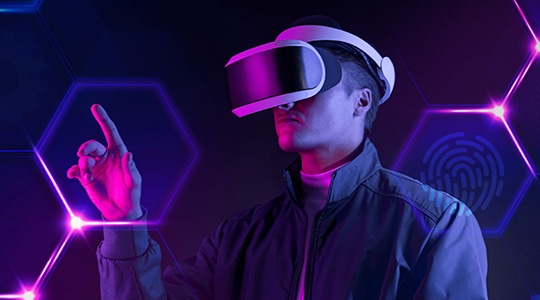Latest Advancements In Virtual Reality
Have you ever thought Augmented Reality was just a sci-fi trope? Interestingly, VR is no longer confined to the realms of gaming. From healthcare simulations to virtual business meetings, the rapid evolution of technology in this field is nothing short of astounding. The future, as it turns out, is not just imagined—it’s virtually built.
In recent years, immersive experiences have been pushed to unprecedented levels. Consider the history: VR’s initial bulky headsets have transformed into sleek, user-friendly gadgets with impressive processing power. A pivotal moment was when Oculus pioneered consumer VR, forever changing digital interaction. Today, industries leverage this technology to create more intuitive and accessible experiences, breaking boundaries like never before.

Latest advancements in virtual reality
Virtual reality (VR) has come a long way since its first introduction. Today, VR offers experiences that feel incredibly real. People can explore distant planets from their living rooms or play games that fully surround them. The advancements in VR now allow for more realistic graphics and smoother interactions. This makes the virtual worlds even more engaging and entertaining for users.
Another significant advancement is in the range of VR devices available. The first headsets were bulky and uncomfortable, but modern ones are sleek, lightweight, and wireless. Popular devices include the Oculus Quest 2 and PlayStation VR. They offer high-resolution displays and impressive audio systems. This convenience helps users dive confidently into virtual spaces.
Industries beyond entertainment have started using VR too. In healthcare, VR helps doctors train by simulating surgeries. Patients use it to reduce pain through distraction. Education benefits as well, letting students explore history by virtually visiting ancient ruins. With VR, the learning and practicing opportunities are vast and varied.
Interestingly, VR is also changing social interactions. Platforms exist where individuals can meet and engage as avatars, much like in real life. This is particularly useful for people separated by long distances. In retail, VR enables users to shop from home by trying on virtual clothes. As technology advances, these virtual experiences will become even more common and accessible.
The rise of immersive VR experiences
Immersive VR experiences have transformed how users interact with virtual worlds. Today, headsets like the Oculus Quest 2 offer full-body tracking and hand controllers. This means your avatar can move like you do in real life. These features make games and simulations feel more realistic. It’s like stepping into another world entirely.
Additionally, VR isn’t just for gaming anymore. Many industries use it for various purposes. For example, architects use VR to showcase building designs to clients. This lets clients walk through a virtual building before it’s built. Companies are finding innovative ways to use VR technology every day.
Another area seeing growth is social VR platforms. Popular apps like VRChat and AltspaceVR let users create avatars and meet others in virtual spaces. Friends can hang out, play games, or join events together. These platforms create a sense of presence and connection. Distance becomes less of a barrier in the digital age.
To make these experiences even more immersive, developers focus on enhancing audio and visual elements. Realistic sound effects follow you around the room, while high-resolution graphics make scenes look stunning. The combination of these aspects helps blur the lines between the virtual and real worlds. VR is becoming more life-like with each advancement.
Application of virtual reality in various industries
Virtual reality has become a powerful tool across different industries. In healthcare, VR is used for training medical students with realistic simulations. These virtual operations provide hands-on practice without risks. Patients also benefit from VR through pain management and physical rehabilitation programs. This technology creates engaging and interactive healing experiences.
The world of construction and architecture uses VR to visualize projects. Architects create virtual walkthroughs for clients to experience designs before they are built. This ensures clients are satisfied and allows changes to be made early. In turn, this saves time and resources. The construction industry is embracing VR to enhance creativity and efficiency.
In education, VR offers students immersive learning opportunities. History classes can take virtual field trips to ancient civilizations. Science experiments can be conducted in a safe and controlled virtual environment. Furthermore, career training programs use VR to simulate real-life work scenarios. This prepares students for the workforce by developing practical skills.
Retail is also revolutionized by VR, enhancing customer shopping experiences. Shoppers can try products virtually before making purchases. Various brands have embraced VR exhibitions and fashion shows. These virtual experiences make online shopping more engaging. VR is providing retailers with new ways to reach and impress their customers.
Role of virtual reality in shaping the future of gaming
Virtual reality is rapidly changing the gaming industry. Gamers are no longer limited to just watching a screen; they can now step into the game world. VR technology has brought a new level of immersion to gaming. High-end VR headsets like the Oculus Rift and PlayStation VR allow players to experience unprecedented realism. The boundary between reality and fantasy is becoming more blurred.
Developers are constantly pushing the limits of what VR can do. They strive to create more interactive and engaging gaming experiences. New games like “Half-Life: Alyx” showcase the potential of VR, offering intricate environments and detailed interactions. Gamers can pick up objects, solve puzzles, and fight enemies. The gameplay feels incredibly lifelike and satisfying.
Multiplayer VR games are also gaining popularity. Players can team up or compete with others in virtual worlds. Social interaction in VR adds a whole new dimension to gaming. It allows players to communicate and collaborate as if they are in the same room. This shared experience makes games more enjoyable and memorable.
Additionally, the rise of VR esports is creating new opportunities for competitive gamers. Tournaments now feature VR games, attracting players and audiences worldwide. This trend is transforming how esports are viewed and played. VR’s immersive nature makes competitions more exciting. Players and spectators alike get closer to the action than ever before.
VR gaming also offers unique physical benefits. Unlike traditional gaming, VR encourages physical movement. Players perform actions such as ducking, jumping, and swinging their arms. This makes the gaming experience more active and engaging. It combines the thrill of gaming with physical exercise.
As VR technology continues to advance, the future of gaming looks more promising than ever. Innovations will lead to even more realistic and interactive experiences. With every development, VR gaming becomes more accessible and appealing. The shift towards immersion is set to redefine the world of gaming.
The impact of virtual reality technology on healthcare
Virtual reality is making significant waves in the world of healthcare. Doctors and surgeons use VR to practice complex procedures without any risk to patients. By simulating surgeries, they can improve their skills and confidence. These virtual training sessions help reduce mistakes during real operations. Hospitals are increasingly adopting VR for such educational purposes.
Pain management is another area where VR proves beneficial. Patients immerse themselves in calming virtual environments, diverting attention from pain. This method works wonders for those undergoing painful treatments, like chemotherapy. It provides a distraction and helps in reducing anxiety. VR is becoming a valuable tool in enhancing patient comfort.
In rehabilitation, virtual reality offers engaging exercises for patients recovering from injuries. Users interact with virtual objects to improve motor skills and regain strength. The interactive nature of VR makes therapy sessions fun and motivating. Patients are more likely to stick to their routines. This innovative approach speeds up the recovery process.
Mental health treatment has also seen improvements with VR technology. It assists in confronting and overcoming fears through exposure therapy. Patients with phobias can face their fears in a safe, controlled, virtual environment. This paves the way for gradual progress without real-world consequences. VR aids in bringing about positive mental health changes.
Moreover, VR helps in diagnosing diseases by providing detailed 3D models. Doctors analyze virtual representations of organs to detect anomalies. This allows for accurate assessments and better decision-making. The precision of VR models contributes to early and effective treatment. Virtual reality is surely transforming the future of healthcare.
How virtual reality is revolutionizing education and training
Virtual reality is changing the way students learn and teachers instruct. In classrooms, VR enables students to explore ancient ruins or other fascinating locations without leaving their desks. This makes learning immersive and exciting. Subjects like history and science become more engaging with interactive, 3D visuals. Students retain information better when they experience it vividly.
Beyond traditional education, VR is vital in vocational training. Trainees in fields like aviation and engineering use VR simulators for hands-on experience. They safely practice tasks that would be dangerous in the real world. This helps them gain confidence and expertise. Such training ensures they’re well-prepared for real-life challenges.
Moreover, VR is making its mark in corporate training. Companies use VR to create lifelike scenarios for employees to practice problem-solving. This innovative approach reduces the need for costly physical setups. It also allows staff to hone their skills repeatedly. VR training leads to better performance and results in the workplace.
Special education greatly benefits from virtual reality too. Students with learning disabilities can explore personalized learning environments. These settings adapt to individual needs, helping them absorb information more effectively. Teachers see improvements in students’ focus and enthusiasm. VR is paving the way for more inclusive educational practices.
To illustrate the revolutionary impact, consider this comparison:
| Traditional Method | VR Method |
|---|---|
| Textbook learning | Interactive simulations |
| Static images | 3D virtual tours |
| Lectures | Immersive experiences |
With continuing advancements, VR is set to redefine education and training practices globally. Both students and professionals benefit from this transformative technology. As VR becomes more affordable and widespread, its positive impact will grow even more significant. Future learning environments will likely include VR as a standard tool for education.
The Future of Virtual Reality
The advancements in virtual reality are reshaping how we interact with digital and physical worlds. Industries from healthcare to education are harnessing VR’s potential, crafting experiences once thought impossible. As technology evolves, VR is poised to become an integral part of everyday life, expanding its reach and impact.
Experts continue to explore VR’s boundaries, promising even more immersive and accessible solutions. As VR becomes more ingrained in our routines, its potential to transform industries and individual experiences grows. The journey of virtual reality is just beginning, and the possibilities are virtually endless.

